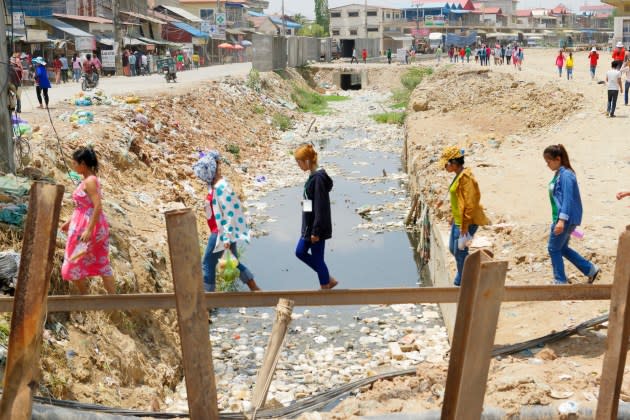Report Finds Fashion Is ‘Ignoring’ Climate Crisis —and Stands to Lose Billions

Showgoer complaints of heat during New York Fashion Week pale in comparison to what’s to come, a new report from Cornell University’s Global Labor Institute and global investment management firm Schroders suggests.
The report analyzed the climate-vulnerability of four key apparel producing regions and 32 apparel production hubs based on the supply chains of six global apparel brands. While risks are widespread, Colombo, Managua, Chittagong, Port Louis (Mauritius), Yangon, Delhi, Bangkok and the Donguuan-Guangdong-Shenzen regions of China all stood out for their “vulnerability.” The research was completed by Cornell University and Schroders, with funding support from both Schroders and the Laudes Foundation.
More from WWD
Lululemon Is 'Listening' in New Impact Report, Says Sustainability SVP
LVMH Métiers d'Art Forms 'One Welfare' University Partnership
The research reveals that extreme heat and flooding will result in “significant disruption days and production losses,” slowing down the industry’s growth and putting $65 billion worth of apparel exports at risk by 2030, or the equivalent to a 22 percent decline. Nearly 1 million fewer jobs are anticipated from this lag.
“Flooding and extreme heat pose significant risk to every constituency in global apparel production — workers, manufacturers, regulators, investors and brands themselves,” said Jason Judd, executive director from Cornell University’s Global Labor Institute, in the report. “But no one is factoring the on-the-ground costs of climate breakdown into their planning. The apparel industry and regulators have mostly framed their climate responses around mitigation issues — emissions, water usage and recycled fabrics. They are ignoring the climate issues that are dramatically and directly affecting suppliers and their workers now. The Global North’s climate nightmares are already in evidence in Bangladesh, Pakistan, Cambodia and elsewhere. Life, let alone work, will become very difficult in these and many other hot spots that apparel brands and retailers depend on for production.”
Pakistan already got the brunt of unprecedented flooding last year, and earlier this year, Dhaka experienced an 11-day heatwave with temperatures soaring to 104.3-degrees Fahrenheit.
Without intervention, workers in these regions are vulnerable to increased illnesses – such as dengue fever and heat fatigue – as well as physical barriers (flooded roads, for instance) preventing their ability to get to work. Productivity hits in two regions alone could be as high as 5 percent of group operating profits, per the study.
The findings underscore the need for brands to be proactive rather than reactive. Efforts include mobilizing climate finance to support standards and protocols for heat and flooding, enforcement measures and social protection systems for workers.
“Apparel companies and brands need to write adaptation investments and measures into their plans,” Judd continued. “Some examples of adaptive investments in factories include green certifications, cooling technologies, such as LED lighting, green or shaded roofs, exhaust and industrial fans, sufficient work breaks and adequate water facilities, all of which can help to stabilize productivity.”
Many launches are strategically timed to New York Fashion Week, like the Conscious Fashion Campaign, which promotes gender equity in the fashion industry in a billboard media blitz, or series of bills.
“Our decision to launch the report this week has nothing to do with New York Fashion Week,” he added. “The report has taken nearly 18 months to produce, all while the issues of heat and flooding have become more intense globally. This is particularly pertinent in light of the wildfires that occurred in North America and Europe over the summer.”
Meanwhile, “Fabric Act” bill sponsor New York Sen. Kirsten Gillibrand said the bill’s relaunch was intentional. “We wanted it to coincide with fashion week. It’s when industry participants come from all over the world….It’s an exciting time to put these issues front and center.”
The pro-labor bill has various “industry fixes,” in the senator’s words, such as elimination of piece-rate pay, joint accountability and instituting a new undersecretary of labor are key elements of the bill.
“It’s basically the same bill,” she told WWD. “There was one tax provision that the industry thought was unworkable that we took out.” (She is referencing the 30 percent on-shoring tax credit, since removed due to feasibility and industry feedback.)
“This bill is really timely because we are seeing a revitalizing of the labor movement across the country. It’s important that we lift labor up,” she added.
There were 80 workers rights activists who met on Capitol Hill Tuesday to advocate for fashion’s federal reshoring effort. Along with general solidarity with the general labor movement, the senator underscored this is an investment in women, too, as the backbone of the industry.
Gillibrand stressed she is optimistic for additional cosponsors, and is in talks with Bipartisan cosponsors.
Best of WWD

